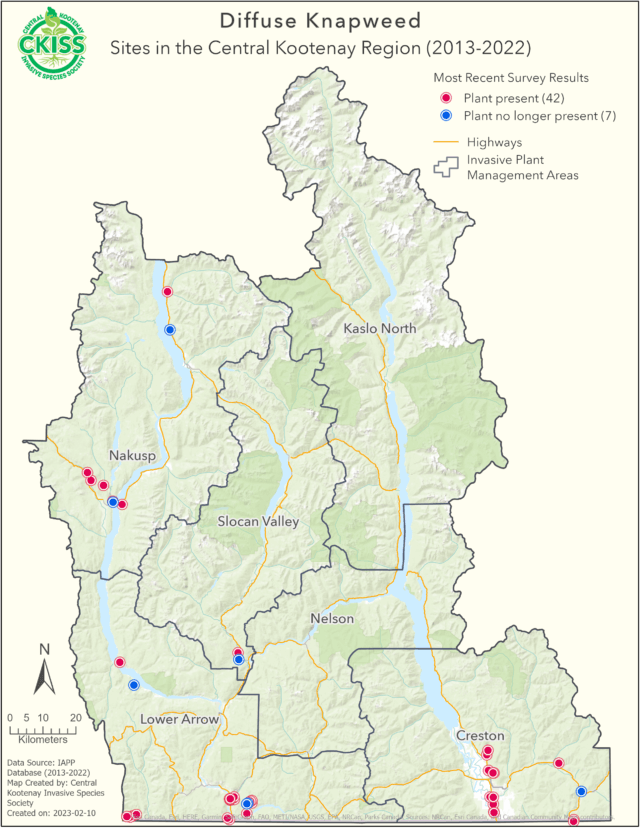Centaurea diffusa
Identification
- Flowers are typically white, but can also be pink or purple.
- Bracts are pale brown-yellow and have a spine at the tip.
- Grows as a rosette in the first year of life.
- In later years, one central stem is produced with many branches, giving the plant a ball-like shape.
- This ball can become a “tumbleweed.”
- Stems and leaves are grey-green.
- Lower leaves are divided, and upper leaves are small and lance-shaped.
- Diffuse knapweed can have a similar appearance to spotted knapweed (Centaurea stoebe), and the two can also hybridize.
Introduction and spread
- This species was introduced to North America through contaminated alfalfa seeds in the late 1800s or early 1900s.
- It has now spread across the United States and Western Canada.
- Seeds can be dispersed by wind, or hitch a ride on boots, clothing, equipment, or vehicles.
- Tumbleweeds may form which can also travel by wind and distribute seeds.
- Contaminated hay may contain diffuse knapweed seeds.
Consequences of invasion
- Outcompetes native species, reducing biodiversity.
- Grasslands are especially vulnerable. Decreases the amount of forage available for wildlife and livestock on rangelands.
- The sharp bracts of diffuse knapweed may injure the mouths of grazing animals.
Status in the CKISS region
- There is currently insufficient information about diffuse knapweed in the CKISS region to assign it a management category on the CKISS Annual Priority List.
- There is insufficient information for this species regarding its distribution, impacts, potential for spread, and/or feasibility of control within the CKISS region.
- CKISS conducts education regarding this species, and may recommend or conduct targeted inventories or risk assessments.
- To learn more about how CKISS classifies and manages invasive species, see our Invasive Species Priority Lists page.
Integrated pest management options
Prevention
- Keep equipment, boots, and vehicles clean to avoid transporting the seeds of diffuse knapweed into new areas.
- Maintain healthy vegetation through proper range management and grazing practices.
- Be PlantWise! Choose only non-invasive species for your garden.
Mechanical treatment
- As seed is the primary mode of reproduction, an effective way to reduce the population over time is to prevent plants from going to seed. Mechanical treatment should occur before plants produce flowers.
- Knapweed can be hand-pulled, ideally before producing seed. This will need to be monitored and repeated annually as the seeds can remain viable in soil for at least eight years.
- If possible, remove the entire plant including the root. However, if managing a larger infestation, removing the shoots and leaves is the priority.
- If you are removing knapweed which has produced flowers, the plants need to be bagged and disposed of at a landfill (flowers may continue to develop into seeds even after being pulled!)
- All landfills within the RDCK and RDKB accept invasive plant species for free. Ensure your material is bagged in clear plastic bags and notify the attendant that you have invasive plant species. Plants must be identifiable through the bag. For more information please see the RDCK Resource Recovery Bylaw.
Cultural
- As this species requires full sun, establishing other vegetation to create shade can produce an undesirable environment for diffuse knapweed.
Biological
- 13 different biocontrol species which impact diffuse knapweed have either been released or migrated into BC.
- These include seed-feeding weevils and moths, root-feeding moths, rusts, and fungi.
- One fungus species, Sclerotinia sclerotiorum, which affects both spotted and diffuse knapweed, is naturally found in BC soils. This agent can also cause disease in agricultural crops, so it is not intentionally redistributed for use as biocontrol for knapweed.






